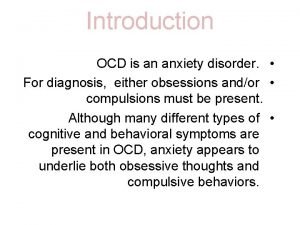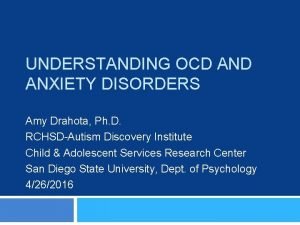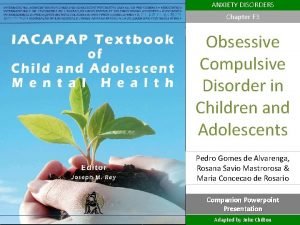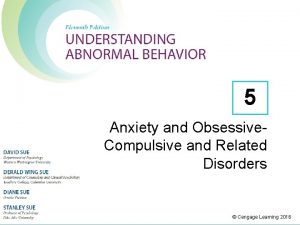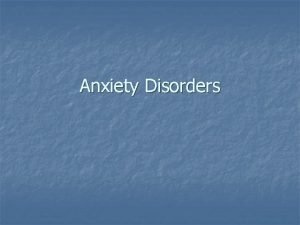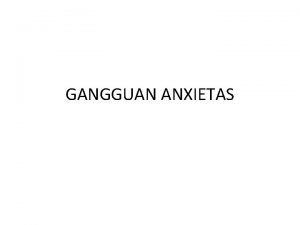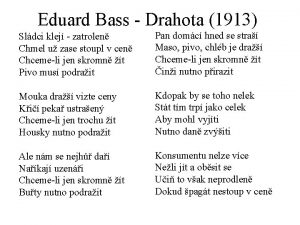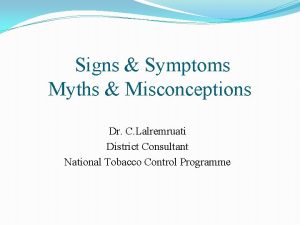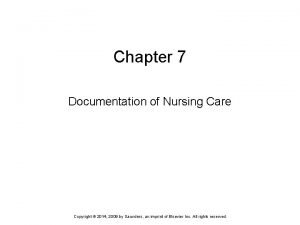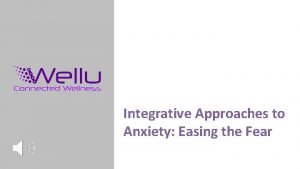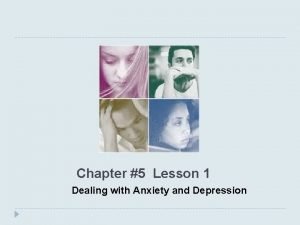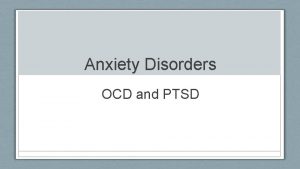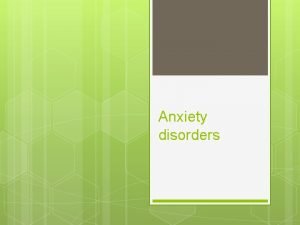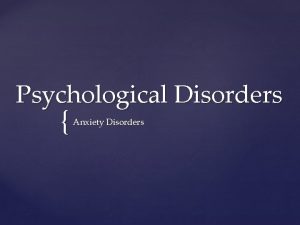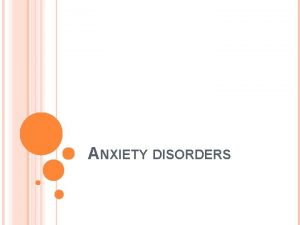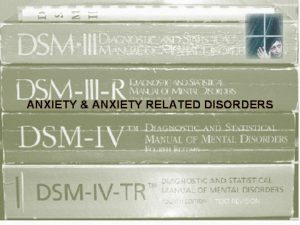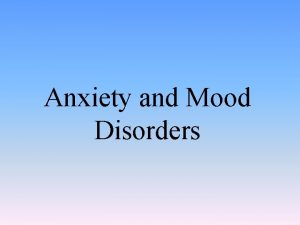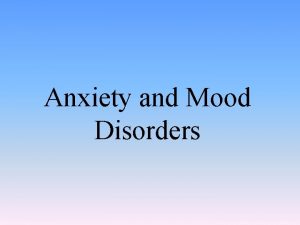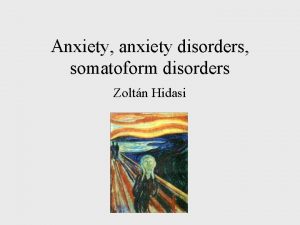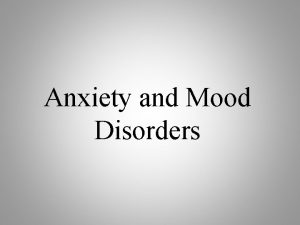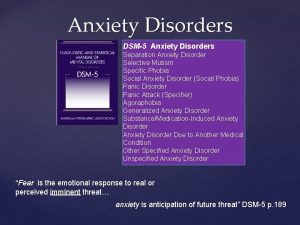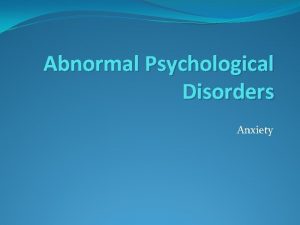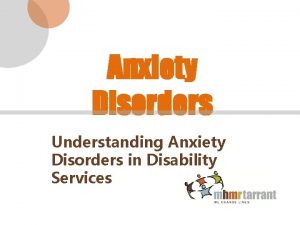UNDERSTANDING OCD ANXIETY DISORDERS Amy Drahota Ph D














- Slides: 14

UNDERSTANDING OCD ANXIETY DISORDERS Amy Drahota, Ph. D. RCHSD-Autism Discovery Institute Child & Adolescent Services Research Center San Diego State University, Dept. of Psychology 4/26/2016

Understanding Anxiety: Conclusions OCD and anxiety disorders are common in children. OCD and anxiety disorders commonly occur together with Tourette syndrome. These disorders may interfere with the daily lives of children who experience them. Children suspected of having anxiety disorders should be referred to mental health professionals.

OCD, Anxiety and Tourette Syndrome § OCD and anxiety disorders are common comorbidities in children with Tourette syndrome § OCD affects 30 -66% of individuals with a diagnosis of Tourette syndrome (American Psychiatric Association, 2013; Hirschtritt et al. , 2015) § Anxiety disorders affect 36% of individuals with a diagnosis of Tourette syndrome (Hirschtritt et al. , 2015)

Understanding Anxiety Fear and anxiety is linked with threat Anxiety is brain-based: Studies show that the limbic system and especially the amygdala are sensitive to cues of danger in the world Once triggered by perception or worry about danger (even just being laughed at in a social situation) these brain structures set off the “fight/flight/freeze reflex” Anxiety is experienced by everyone, but becomes are problem when interferes with one or more areas of life

Understanding Childhood Anxiety OCD and Anxiety disorders are among the most common psychiatric disorders affecting children and adolescents (Albano et al. , 2003) Estimated collective prevalence rate: 6 to 15% (Benjamin et al. , 1990; Briggs-Gowan, 2000; Costello, 1989) Anxiety disorders involve: Behavior: Avoidance of feared things Cognitions: Fearful beliefs and attributions Affect: Negative affect and physiological arousal Anxiety disorders: Separation anxiety, Selective mutism, Social phobia, Generalized anxiety, Specific phobia and Panic disorders. OCD is its own diagnosis category

Obsessive-Compulsive and Related Disorders • • • Core Features Age of Onset Common Behaviors

Obsessive-Compulsive Disorder Core features Obsessions are recurrent and persistent intrusive and unwanted thoughts, urges, or images Compulsions are repetitive behaviors or mental acts that an individual feels driven to perform in response to an obsession or according to rules that must be applied rigidly Average of onset is 19½ years; 25% of cases start by age 14 years old. Boys typically have earlier onset than girls Common behaviors Time-consuming Causing clinically significant distress or impairment

Specific Anxiety Disorders • • • Core Features Age of Onset Common Behaviors

Separation Anxiety Disorder Core features Overwhelming fear of losing or being separated from parents or caregivers through catastrophic means Most prevalent anxiety disorder in kids younger than 12 years; can occur at any age & into adulthood Common behaviors Difficulty transitioning from home to other places or refusal to leave home or separate from caregiver May consistently feel sick upon arrival to appointment Multiple requests to leave the appointment Avoidance of activities with peers or others Difficulty concentrating due to worry for self or caregiver Distress and preoccupation with separation

Selective Mutism Core features Development & Course Children do not initiate speech or reciprocally respond when spoken to by others in specific social situations Yet, children generally have normal language skills Prevalence: 0. 03% to 1%, depending on study settings & ages Onset often before 5 years old but interference noticed at school Clinical observations suggest that kids may “outgrow” SM but empirical data is lacking Common behaviors Refuse to speak in social situations Clingy behavior to caregivers or trusted adults Mild oppositional behavior and temper tantrums

Social Phobia / Social Anxiety Core features Marked fear and panic while in or anticipatory anxiety about 1+ social situations in which there could be embarrassment, rejection, or scrutiny For children, must occur in peer setting & not just with adults Social situations are avoided or endured with intense fear Most often diagnosed in adolescents but does occur in earlier childhood Common behaviors Crying and/or temper tantrums Freezing or shrinking in social situations Clinging

Generalized Anxiety Core features Excessive worry about a number of events or activities, which is difficult to control and has associated physical symptoms (restlessness, fatigue, difficulty concentrating, irritability, muscle tension, sleep problems) Common behaviors Repeated or “out-of-the-blue” questions/comments about the worried event/activity Distraction and interference with the task at hand Refusal to try tasks; perfectionism Trembling, twitching, shaking, muscle aches and soreness Somatic symptoms & exaggerated startle response

Understanding Anxiety: Conclusions OCD and anxiety disorders are common in children. OCD, anxiety disorders and mood disorders commonly occur together. These disorders may interfere with the daily lives of children who experience them. Children suspected of having anxiety disorders should be referred to mental health professionals.

THANK YOU! Any questions or discussion?
 Ego syntonic and ego dystonic
Ego syntonic and ego dystonic Amy drahota
Amy drahota Ocd prevalence
Ocd prevalence Multipath model of anxiety disorders
Multipath model of anxiety disorders Chapter 15 anxiety and obsessive-compulsive disorders
Chapter 15 anxiety and obsessive-compulsive disorders Anxiety disorders def
Anxiety disorders def Icd x anxiety disorders
Icd x anxiety disorders Eduard bass drahota
Eduard bass drahota Anxiety lan chhuah dan
Anxiety lan chhuah dan Documenting nursing notes examples
Documenting nursing notes examples Uw integrative medicine
Uw integrative medicine Examples of directional hypothesis
Examples of directional hypothesis Alfred adler was a neo-freudian who coined the term *
Alfred adler was a neo-freudian who coined the term * Chapter 5 lesson 1 dealing with anxiety and depression
Chapter 5 lesson 1 dealing with anxiety and depression Levels of anxiety nursing
Levels of anxiety nursing
